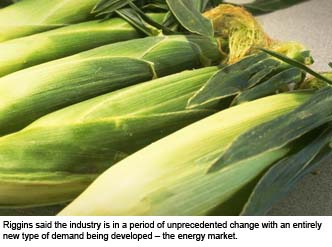Corn Producers See Continued Strong Demand
Corn Producers See Continued Strong Demand

Demand for corn to produce ethanol continues to escalate, making the commodity’s outlook for the next few years a rosy one, said a University of Kentucky College of Agriculture grain marketing specialist.
Within-season corn prices could fluctuate as much as $2.50 between the low and the high over the next two years, and prices could set a new all-time high within the next one to two years, said Steve Riggins, UK agricultural economist. The previous record high price of $5.50 was set 10 years ago.
“Most of that action will occur after the first of January,” he said. “What the market is trying to do right now is to choke back consumption from the projected all-time corn demand to try to preserve some for the 2006 crop that’s left and carry it into 2007.”
Riggins said the industry is in a period of unprecedented change with an entirely new type of demand being developed – the energy market. As the demand for corn-for-ethanol production increases, it competes with existing markets for the commodity, particularly livestock feed and exports. Those markets continue to be strong as developing countries, especially China, add more meat to their diets.
Ethanol production isn’t likely to slow down without substantial increases in corn prices and decreases in crude oil. However, high corn prices could cause some livestock producers to look for other alternatives.
Because of high demand, the amount of corn on hand is low and could reach record lows. Corn usage is expected to be more than 12 billion bushels next year and that’s larger than any corn crop ever produced. To meet demand, there needs to be a minimum of 6 million additional corn acres planted next year or new hybrids that will average 170 bushels per acre. The current record yield is 160 bushels set in 2004.
“The question is, where will the acres come from?” Riggins said.
Currently 36 million erodible acres are idled through the federal Conservation Reserve Program. Contracts on 16 million will be eligible to expire sometime in 2007 but most will be after July and too late to be planted in 2007, he said. Some projections are that 12 million acres eventually will be brought back into production, with 9 million going back into row crops such as corn and soybeans.
“The land base is there,” Riggins said. “We haven’t solved the farm income problem for the long term. We have the capacity to produce back to low prices. This is not a long-run solution, but we are going to have a commodity price bubble of two, three, maybe four years of unprecedented profit opportunities in large-scale commercial grain agriculture before prices return closer to the price of production. In the short run, it is a great opportunity.”
In addition to producing itself back to low markets, there are other things that could make the bubble burst, including much lower energy prices and changes in government agricultural or energy policies. Ethanol currently has a federal tax credit that helps its profitability.
“Another fly in the ointment would be Brazil and its capacity to raise a lot of sugar cane and ability to raise a lot more,” Riggins said.
The break-even cost of producing ethanol from corn is about $1.10 to $1.30 per gallon. Brazil can make it for 89 cents using sugar cane.
“This is just a short run windfall,” he said.
